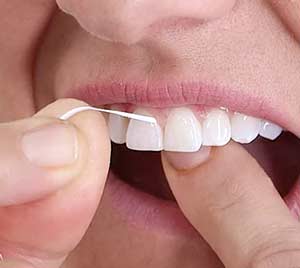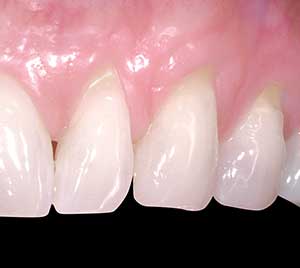Search Results
161 content pages
How To Floss Your Teeth
You always brush twice a day, avoid sugary snacks between meals, and go to the dentist regularly. Do you still have to floss your teeth?
The short answer: Yes, at least once a day. Flossing is probably your single most important weapon against plaque, the clingy bacterial biofilm that sticks to the surfaces of your teeth. Plaque is the principal cause of tooth decay; it is also the cause of periodontitis (gum disease), bad breath, and other maladies. Brushing is a good start — but flossing removes plaque in places a brush can't reach, like the small gaps between teeth...

Frequently Asked Questions About Dental Implants
What are dental implants?
Dental implants are small titanium posts that replace the roots of missing teeth (View Example). They are inserted into your jawbone during a minor surgical procedure that takes place in the dental office. After the implant has been placed in your jawbone, a completely lifelike porcelain tooth crown is attached. In some cases, the implant needs to fuse with the bone for several months before it is permanently crowned; in other cases, you can have new (but temporary) teeth the same day your implants are placed.
How many teeth can be replaced with dental implants?
You...

Common Dental Problems
Just as you go through different stages in life, you may have different concerns about your dental health at various times. Some problems — tooth decay and dental injuries, for example — may be an issue at any time; others tend to occur more often at certain ages. Let's look at some of the most common dental concerns, from childhood through the golden years.
Children
Tooth decay, caused by oral bacteria, remains the most prevalent chronic disease of childhood (and adulthood). Yet it is highly preventable with good oral hygiene, a diet low in sugar, and regular checkups at the...

Orthodontics and Surgery
Most of the time, individuals with misaligned teeth or other bite problems can be successfully treated with the many types of orthodontic appliances now available. Jaw development in a growing child can even be guided to improve tooth alignment when appropriate treatment is received before puberty. But sometimes, orthodontics alone isn't enough to correct problems with the teeth or jaws. That's when a surgical approach may be needed.
Corrective jaw surgery (also called orthognathic surgery) may be recommended for orthodontic problems that are skeletal in nature — meaning the misalignment of the bite is caused not by the position of...

Gum Recession
You may not know what gum recession is — but if you've heard the phrase “long in the tooth,” you already know one thing about this condition: It is indeed responsible for making your teeth seem longer. It may also be associated with increased age, as the saying suggests. But because gum recession is a gradual process, it is often difficult to notice while it's occurring. Besides appearing to “lengthen” teeth, other symptoms of gum recession may include tooth sensitivity and an uneven gum line.
Causes of Receding Gums
There a number of things that can cause gums to recede,...

Aging and Dental Health
Today, Americans are not only living longer — we're also retaining our natural teeth longer than ever before. But this rosy picture isn't free of thorns: Older adults tend to require increasingly complex dental treatments; are often more prone to contracting certain diseases; and sometimes find it challenging to keep up with daily oral health practices.
Yet maintaining good oral hygiene is critically important as we age. When problems occur in the mouth, they can cause difficulty chewing, swallowing, speaking and smiling — basic functions which can affect both physical and social well-being. It's possible that medications prescribed for other...

Geographic Tongue
Geographic tongue is characterized by harmless lesions, or patches, that can suddenly materialize on the tongue's top surface. The condition gets its name from the physical appearance of the lesions, which resemble smooth, red islands, possibly rimmed with white. Their smoothness comes from the absence of the tiny bumps or “papillae” that normally cover the entire surface of the tongue. These variations in color and texture give the whole tongue a map-like appearance.
The pattern on the tongue can change daily as the lesions appear to move or migrate, healing in one spot only to reappear in another. That's why...

General Dentistry
The practice of general dentistry encompasses an amazing array of services and procedures, all with a common goal: to help you to preserve your natural teeth as long as possible, ensure your oral health, and keep you looking and feeling great throughout life.
Oral health is an essential component of general health. In fact, medical research has revealed links between common oral infections and serious general health conditions including cardiovascular disease. It is therefore of the utmost importance to maintain the health of your teeth, gums, and other oral tissues.
This should start in childhood, so that health-promoting habits can...

Fluoride and Your Teeth
Fluoride is a mineral that is naturally present to some degree in both fresh and salt water sources. Its major dental benefit is that it is readily incorporated into the teeth's mineral structure, thereby making them stronger and more decay-resistant. Fluoride can even reverse tiny cavities that are starting to form. Less tooth decay (professionally defined as “caries”) means you have a better chance of avoiding significant dental treatments — and keeping your natural teeth for life.
The great majority of toothpastes sold today contain fluoride, because it's an effective, easy and inexpensive way to prevent tooth decay and promote...

Ultrasonic Scalers
When it comes to cleaning your teeth, few dental instruments can match the power and speed of an ultrasonic scaler. Ultrasonic equipment was first used in dentistry back in the 1950s; today, ultrasonic scaling is a mature and time-tested technology. In experienced hands, these high-tech instruments can disrupt and flush away bacteria along with hard deposits that your toothbrush can't touch — and they can even help moderately stained teeth look brighter.
Chances are you may already be familiar with ultrasonic scalers — or at least, your teeth are. They are the tools of choice for many dentists and dental...

Laser Dentistry
They are inside your laptop computer and your DVD player, present on the factory floor and the supermarket checkout line. And now, lasers are finding increasing use in dentistry. Someday soon, you may have a routine dental procedure performed with the aid of a powerful, yet highly controllable beam of laser light, instead of a drill or a probe.
What are dentists currently using lasers for? These devices have been proven to help in the detection and treatment of oral diseases. They can be used for treating gum disease, detecting cancer, and pinpointing tooth decay in its early stages. They...

Palatal Expanders
A major benefit of receiving orthodontic treatment in childhood is that it's possible to take full advantage of a youngster's own natural growth process to treat or even prevent malocclusions (“bad bites”). A palatal expander is a device designed to help do that.
Palatal expanders create more space in a child's mouth by gradually widening the upper jaw. Although this may sound scary, it's really quite easy — both to do and to tolerate. That's because the upper jaw (maxilla) actually develops as two separate halves that don't completely fuse together until sometime after puberty. Before that happens, the two...

Dry Mouth
Everybody gets a dry mouth from time to time. Temporary mouth dryness can be brought on by dehydration, stress, or simply the normal reduction in saliva flow at night. But persistent mouth dryness, a condition known as xerostomia, is cause for concern.
Xerostomia occurs when your salivary glands, which normally keep your mouth moist by secreting saliva, are not working properly. A chronic lack of saliva has significant health implications. For one thing, it can be difficult to eat with a dry mouth; tasting, chewing and swallowing may also be affected. This could compromise your nutrition. Also, a dry mouth...

Diabetes And Oral Health
Diabetes is a group of chronic inflammatory diseases that affect the body's ability to process sugar. If you have diabetes, it is particularly important to maintain excellent oral health. That's because diabetics are more prone to oral infections such as periodontal (gum) disease, which can result in tooth loss if left untreated. Conversely, the presence of gum disease can make it harder for people with diabetes to control their blood sugar levels.
Periodontal disease is a chronic ailment that is also associated with an elevated level of systemic (whole-body) inflammation. Like diabetes, it may have wide-ranging consequences outside the mouth...

Dental X-Rays
X-rays are such a routine part of regular dental care today that it’s hard to imagine what a truly revolutionary impact they have made in dentistry. Discovered by German scientist Wilhelm Röntgen in 1895, x-rays were first utilized by doctors for viewing internal bodily structures in the early 20th Century. By mid-century, dentists were routinely using the technology to diagnose tooth decay and periodontal (gum) disease, as well as other diseases that are not visible through a clinical examination. The ability to see what’s inside the tooth and catch decay or gum disease at early stages has vastly improved the...